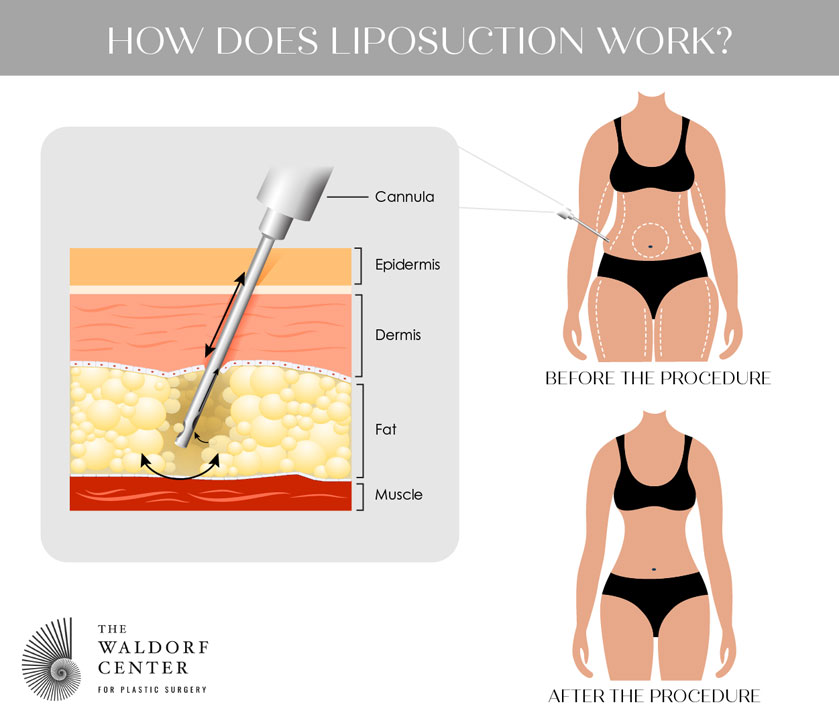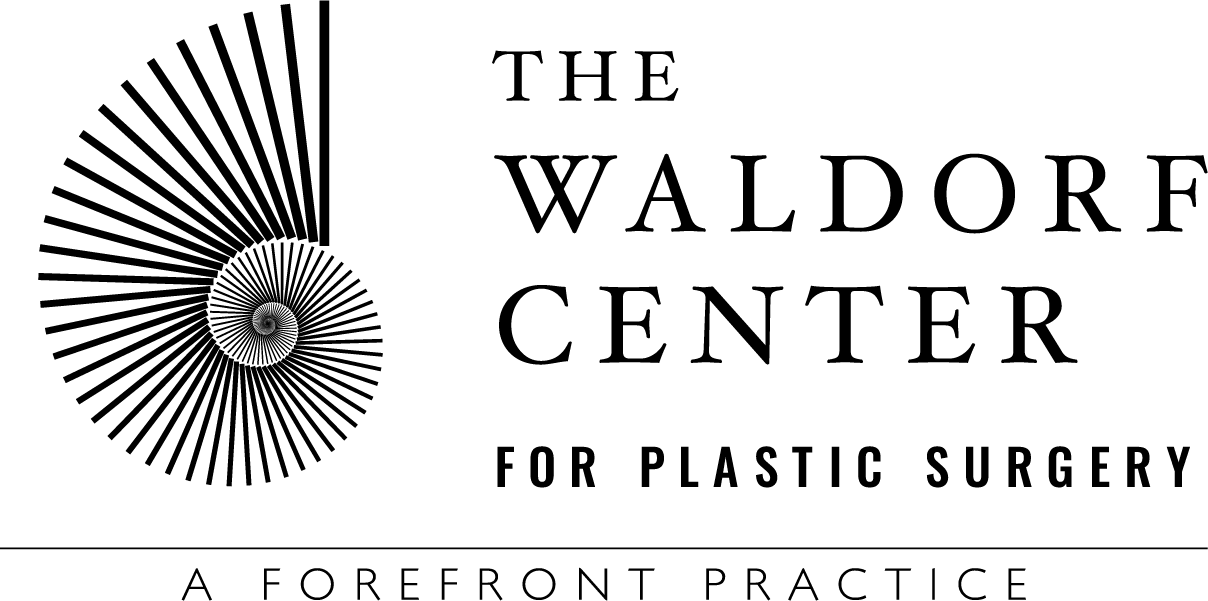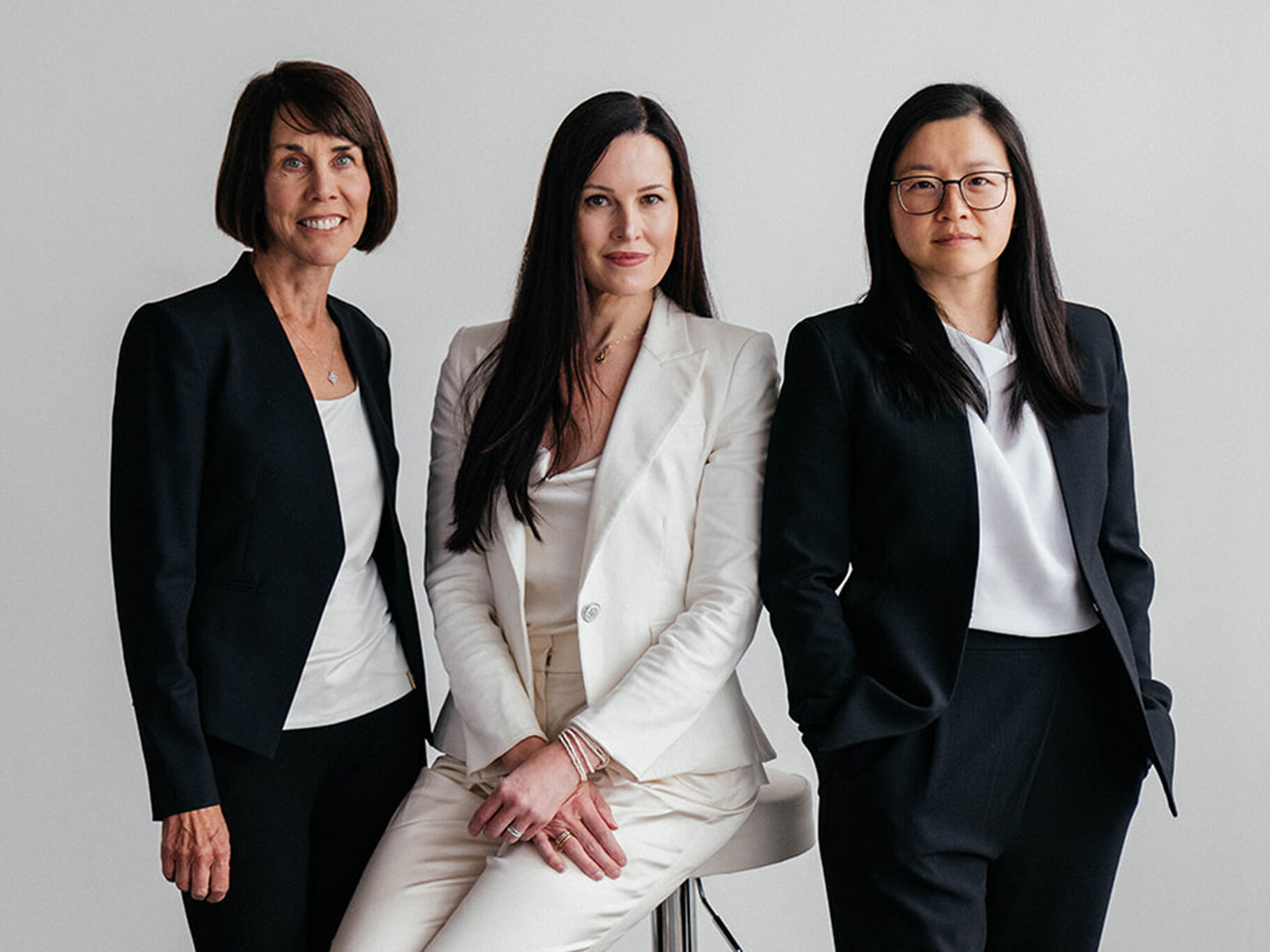- Home
- SURGERY
- Body Surgery
- Liposuction
LIPOSUCTION
SURGICAL FAT REDUCTION SCULPTS NEW CONTOURS AND
PROPORTIONS AT OUR PORTLAND, OR, PRACTICE
FAQS
From the chin to the abdomen to the ankles, liposuction at Portland’s Waldorf Center is an effective body-sculpting procedure that provides customized contours by surgically removing stubborn fat deposits virtually wherever they are found. In addition to the areas mentioned above, surgical fat reduction can also target the neck, waist, back, arms, underarms, buttocks, hips, thighs, knees, and calves. Essentially, if there is a place on the body where fat cells seem to resist the effects of all lifestyle changes, liposuction can help.
Beyond fat reduction, liposuction techniques can also be used to strategically move and reposition the fat that remains behind. This strategy—popular with patients in 2025—is known as liposculpture, as it goes beyond reduction in order to shape proportional life.
The experienced and talented board-certified plastic surgeons and clinical providers at The Waldorf Center work directly with patients who have a variety of body types and a range of aesthetic goals. Some of these patients are ultimately looking for overall body contouring, while others want to get rid of a specific small pocket of fat—such as a double chin—that won’t go away despite a committed exercise plan and strict diet. For many patients, physically removing the fat is the best option, which shows that liposuction is a go-to procedure for adults of all ages.
CONTACT US
Talk to The Waldorf Center for Plastic Surgery about liposuction results, prices, before-and-after photos, and more in Portland, OR. Patients in Salem, Vancouver, and beyond can call 503-882-0124 or 1-800-501-6548 to find out more today, or schedule a visit online.
There are non-surgical fat-reduction options—such as CoolSculpting® to freeze unwanted fat cells and Kybella® to reduce a double chin—and while these are very effective options, the results they provide are not as dramatic as what is possible with surgery. Given the options, patients often choose liposuction. The surgical results tend to be more predictable, more consistent, and quicker to appear when compared with the alternatives.
While multiple treatment sessions of a non-surgical procedure spread out over time may be required to help patients achieve their fat reduction goals, just one liposuction procedure may be all that it takes to sculpt or slim down areas of concern.*
That said, it is important to remember that liposuction is not a weight-loss procedure, is not intended to help patients improve their health, and is not an obesity treatment. It is a cosmetic procedure that reduces stubborn pockets of exercise-resistant fat beneath the skin. While liposuction can “debulk” areas when there are disproportionate-looking fat deposits, patients should not choose the procedure thinking that it will result in significant weight loss.
WHAT MAKES AN IDEAL LIPOSUCTION CANDIDATE?
Anyone who has at least one pocket of fat that seemingly refuses all attempts to reduce it may be a good candidate for liposuction. Surgical fat reduction is, of course, intended for people who want to alter their body contours, so a desire to make a change is a must.
Healthy patients enjoy the best results and have fewer complications, so Waldorf Center liposuction patients should avoid smoking, maintain a body weight that is at or within 30 percent of the ideal for their height, have good muscle tone, and have firm, healthy, and elastic skin that will tighten over the new body contours after the procedure. In general, candidates should be in good overall health and have realistic expectations of what their procedure can accomplish.

Liposuction at Portland’s Waldorf Center involves inserting a specialized tube, known as a cannula, through the skin’s surface and into the fat-filled area between the dermis above and the muscle below. Moving the cannula back and forth dislodges the fat cells, which are then suctioned out through the tube. This reduces the volume in the treatment area, resulting in slimmer contours.
WHAT HAPPENS AT YOUR LIPOSUCTION CONSULTATION IN PORTLAND?
Patients considering liposuction will understandably have questions about the surgical fat removal procedure. Common topics that prompt patients to seek answers include how to prepare for the procedure, how much liposuction costs, and what to expect during the recovery process.
Men and women in and around Portland, Salem, and Vancouver—as well as more distant areas—are encouraged to bring their liposuction and other plastic surgery questions to their plastic surgeon of choice for honest answers, after which they can decide whether the procedure is right for them.
There are many different liposuction techniques available, including ultrasound-assisted liposuction, power-assisted liposuction, and tumescent liposuction. Although each of them features unique aspects, they all have the same purpose: to loosen unwanted fat cells and remove them from the body. You will discuss the technique that may be most beneficial for you during your consultation with your plastic surgeon.
Liposuction may be performed on its own, or it may be included as part of another surgical procedure. Surgical fat reduction helps to remove volume as part of a breast reduction, harvest cells for a fat transfer breast augmentation, or address stubborn fat as needed in a tummy tuck, arm lift, thigh lift, or lower body lift.
The Waldorf Center team knows that the choice to undergo surgical fat reduction is a personal and serious one. Each member of our team is dedicated to making sure our patients are equipped with everything they need to decide—and that they are comfortable with their choice of surgeon for liposuction. Feeling confident helps with better post-procedural recovery and maximizes results.
Calculate your own BMI
UNDERWEIGHT
18.5 or below
NORMAL
18.5 to 24.9
OVERWEIGHT
25 to 29.9
OBESE
30 or more
Once a patient has decided on liposuction, many emotions may come into play. Patients often express that they feel excited about the surgery to come, with many adding that they also feel a bit nervous. All of this is natural and normal.
In the weeks prior to the surgery, they Waldorf Center team may ask patients to make some minor lifestyle changes as necessary. For example, patients should stop smoking or drinking alcohol long before their scheduled surgery date. Patients may also need to adjust or temporarily suspend their consumption of certain medications and supplements. In order to ensure that everything goes as smoothly as possible, Dr. Kathleen Waldorf, Dr. Rachel Streu, or Dr. Heidi Johng will talk with you about your full medical history. They may also order lab tests to determine the current state of your health.
When it comes time for the procedure itself, patients are typically told to stop eating or drinking at least 12 hours before their surgery. Liposuction is known as an outpatient procedure or day surgery, which means that it doesn’t usually require patients to stay overnight in the hospital.
The Waldorf Center team highly encourages patients to ask a friend, family member, or partner to be available to drive you home after your procedure, as well as to watch over you during the next 24 hours. The anesthesia used to reduce sensation during the surgery may cause you to feel drowsy or disoriented, and it can also slow your reflexes during this time. That means you should definitely avoid driving a vehicle or operating any heavy machinery for a day after your liposuction.
The three most common forms of liposuction available for patients are ultrasound-assisted, power-assisted, and tumescent. Tumescent liposuction involves infusing the treatment area with a sterile solution to reduce blood flow and sensation, as well as to firm the tissue to better facilitate fat extraction. The fat cells may then be broken up manually with a thin tube called a cannula, or the plastic surgeon may use a power-assisted technique that vibrates to break up the unwanted fat prior to removal. The cannula itself moves in a rapid, back-and-forth motion. This fast, safe method is especially useful on tough fat or large volumes of fat. Ultrasound-assisted liposuction uses energy to “melt” the fat rather than breaking it up with physical action.
The cannula is then used to suction out the fat.
WHAT STEPS DOES A LIPOSUCTION PROCEDURE INVOLVE?
Liposuction (sometimes referred to as lipoplasty or suction-assisted lipectomy) is performed through small incisions (about a quarter of an inch each) made around the areas being treated. A saline solution that also contains a local anesthetic and a medication to constrict the small blood vessels is injected into the surgical site. This makes them easier to remove, reduces blood loss and bruising, and helps with post-operative pain management.
The surgeon then inserts through the incision a hollow tube known as a cannula. The tube serves as a wand that loosens and breaks apart the fat cells, turning the unwanted fat into a more liquefied form that is easier to remove. The cannula is also attached to a machine that applies suction to remove the loosened fat deposits while the surgeon guides it. Since fat cells are distributed differently throughout each person, the procedural details of each case are unique.
Depending on the case (as mentioned earlier), the surgeon may also use ultrasonic-assisted liposuction or laser-assisted lipolysis to aid in the removal of undesired fat deposits in certain areas of the body. These techniques make use of either an ultrasound device or a laser—as opposed to manually applied force—to assist in breaking up the fat cells, making them even easier to remove and providing a smoother result.
Lipo procedures usually take one to two hours to complete, and may be performed using a variety of anesthesia options.
Liposuction is an outpatient procedure, so you will go home the same day. As driving is not recommended for 24 hours after being under general anesthesia, you will require someone to take you home from the surgical center.
Liposuction (also sometimes referred to as lipoplasty or suction-assisted lipectomy) involves the plastic surgeon making small incisions—about a quarter of an inch each—in the area or areas being treated. For the tumescent approach, a saline solution that contains a local anesthetic and a medication to constrict the small blood vessels will be injected into the surgical site. This makes the fat cells easier to remove, reduces blood loss and post-procedural bruising, and helps with pain management during recovery.
A hollow tube known as a cannula will then be inserted through an incision. The tube has a dual purpose. First, it serves as a wand made to loosen and break apart the fat cells. This frees the unwanted fat cells so that they take on a more liquefied form. Breaking up the fat makes it easier to remove.
Second, the cannula is attached to a machine that creates suction. As the surgeon guides the cannula around the treatment area, the tube draws out the loosened fat deposits and removes them from the body. Note that since fat cells are distributed differently throughout each person, a patient’s specific procedural details will be unique.
Depending on the patient, the surgeon may also use ultrasonic-assisted liposuction or laser-assisted lipolysis to help with the removal of stubborn fat deposits in certain areas of the body. These strategies involve the use of either an ultrasound device or a laser—as opposed to the physical motion of the cannula—to help break up the fat cells for easier removal and a smoother, more even result.
Lipo procedures usually last about one to two hours. Any of a variety of anesthesia options may be used, but this detail will be discussed with you during your initial consultation.
Liposuction is an outpatient procedure, so patients will go home the same day as their surgery. Since driving is not recommended for 24 hours after being under general anesthesia, someone will have to take you home from the surgical center.
Body contouring is a popular choice at The Waldorf Center for Plastic Surgery. Liposuction and tummy tuck are two of the most popular choices, since they provide significant results that can slim down a person’s silhouette—and patients typically want to know more about both procedures so they can understand what the two have in common and what sets them apart.
With a focus on patient education, The Waldorf Center is always aiming to equip patients seeking an aesthetic change with the knowledge they need to choose the procedure, treatment, or combination of options that will best help them on their journey of personal transformation.
Liposuction is strictly a fat-reduction procedure. It does not correct muscle laxity or loose skin a patient may be dealing with either before or after the surgery. For this reason, lipo is recommended for patients who are already near their ideal weight and those who have healthy skin that can conform to the new, slimmer contours.
Patients who are likely to find themselves with sagging, excess skin after their liposuction procedure may also want to consider a skin-tightening surgery. Everything from a facelift to a thigh lift is available. Loose skin removed from the abdomen is most often done so as part of a more comprehensive procedure known as an abdominoplasty—but more commonly called a tummy tuck.
A tummy tuck is not intended to be a fat-removal surgery, although it may include some liposuction to help achieve natural-looking, slim contours. The fat removed during a tuck is less than liposuction alone would remove.
Since the main focus of abdominoplasty is removing loose skin, it can involve excising just the redundant tissue found below the navel or a larger amount spanning the entire abdomen. The surgery also frequently includes the doctor tightening abdominal muscles and supportive tissues that have been stretched out by large fat cells.
While abdominoplasty can further enhance the results of liposuction, it is often used to counter the sagging aftereffects of massive weight loss due to medical intervention, surgery, or simple diet and exercise. A tuck can also help new mothers restore the contours of their pre-birth bodies by repairing the muscles stretched out by a growing baby.*
THREE TALENTED DOCTORS
ONE FOCUSED MISSION
The experienced surgeons at The Waldorf Center for Plastic Surgery—Dr. Kathleen Waldorf, Dr. Rachel Streu and Dr. Heidi Johng—built the practice on a foundation of providing patients with high quality, ethical care. One of their guiding principles is a belief that cosmetic surgery is as much an art as it is a science.
The experienced surgeons at The Waldorf Center for Plastic Surgery—Dr. Kathleen Waldorf, Dr. Rachel Streu and Dr. Heidi Johng—built the practice on a foundation of providing patients with high quality, ethical care. One of their guiding principles is a belief that cosmetic surgery is as much an art as it is a science.
Special Financing Available
The Waldorf Center in Portland, OR, offers special financing for the recommended surgical or non-surgical procedure you want. Convenient monthly payments can be structured to fit your financial situation. Call the practice for more information at 503-646-0101 or contact us online.
The plastic surgeons at The Waldorf Center for Plastic Surgery always work with each patient with an ultimate look in mind. At your consultation, your plastic surgeon will recommend whether liposuction, a tuck, or a combination of the two will best yield your desired results. The decision will depend on a multitude of factors, including the amount of fat to be remove, the degree of muscle laxity present, and severity and amount of loose skin involved.
Liposuction, tummy tuck, and more options are available. Call 503-646-0101 or 1-800-310-7901 to learn more, or schedule a consultation online.
Due to the nature of liposuction, fat-reduction results are technically visible as soon as the surgery is complete. Once the fat cells are out of the body, the volume they created is gone. That said, it will take a bit of time for the ultimate long-term results to appear due to post-procedural swelling. Other side effects to watch for after the surgery include bruising and soreness in the treatment area or areas. Depending on how involved the surgery way, patients can expect up to three months before they are able to clearly see their final results after any post-surgical conditions resolve.*
Recovery from the surgery itself is relatively quick. Most liposuction patients find they can return to their typical routines at home or at work within one to two weeks after their procedure. Note than vigorous physical activity should be avoided for a few more weeks after this. Patients will wear compression garments during the first several weeks after their surgery in order to limit fluid accumulation, help control any swelling, and improve the look of the final result.
Most patients can fully return to their preferred exercises and other physical activities in about four to six weeks.* It is important to emphasize that while liposuction physically removes fat cells from the body, it does not prevent patients from putting on new weight. Consuming more calories than are used can cause the remaining fat cells to expand, which can create new bulges and “undo“ the results of a liposuction procedure. In these cases, it is also possible that your body will begin to store fat in new locations, causing bulges to appear somewhere other than the area treated with liposuction. In order to maintain the results long-term, patients should be committed to sustaining a healthy lifestyle with appropriate diet, exercise, and other habits. Understand that weight gain, pregnancy, and the natural aging process may affect the results of liposuction over time.
Because liposuction is not meant to get rid of all of the unwanted fat cells in the body or a given treatment area, it is possible for new deposits to accumulate—especially if positive lifestyle habits are not being maintained. It can be helpful to have a lifestyle plan in place before the surgery in order to create conditions that lead to lasting results afterward.
Maintaining new contours after liposuction is an easier endeavor if healthy eating and regular exercise are already part of a patient’s routine before the fat-reduction surgery. If you establish these habits well in advance of the liposuction procedure, returning to them after your recovery will be second nature.
Special Financing Available
The Waldorf Center in Portland, OR, offers special financing for the recommended surgical or non-surgical procedure you want. Convenient monthly payments can be structured to fit your financial situation. Call the practice for more information at 503-646-0101 or contact us online.
As with all surgical procedures, liposuction does carry a certain amount of risk. It is important to the Waldorf Center team that you understand these risks, as well as the possible complications or adverse events associated with the surgery.
Your plastic surgeon will discuss the potential risks with you during your consultation and your pre-operative appointments. These are also ideal times to ask any questions you may have about the procedure in general, specifics related to the practice and the surgeon in particular, and anything else you want to know about liposuction and related body-contouring surgeries.
Our experienced plastic surgeons at the Waldorf Center have significant history with liposuction, having worked with a diverse array of patients over many years. They understand how to help each patient achieve the best results possible, all while minimizing risks before, during, and after the surgery.
Understanding the benefits and potential challenges of the procedure, as well as expected timelines and realistic results, can lower stress and allow for a faster, easier recovery.
As mentioned above, liposuction can be part of many other surgical procedures that involve fat reduction to reduce volume or fat transfer to augment other areas of the body. Fat grafting requires the careful removal and processing of healthy fat cells, which are then injected in small amounts into creases on the face for a smoother surface, as well as to even out postsurgical or age-related contour irregularities.
Surgical fat removal is not the only body contouring procedure available at The Waldorf Center. Patients seeking the removal of loose skin at their abdomen may choose a tummy tuck to tighten the belly. Liposuction and a tuck together may be elements of a Mommy Makeover, which is designed to help women regain the look of pre-pregnancy body contours.*
Patients who are not yet ready for the dramatic results of surgery have nonsurgical options, too, including Kybella® injections to chemically break up the fat that composes a double chin, CoolSculpting® to “freeze” and reduce large and small stubborn pockets of fat all over the body, and EMSCULPT® to stimulate muscle contractions that tone the abs and buttocks while metabolizing small amounts of fat away for fine-tuning the physique.
Contact the Waldorf Center for Plastic Surgery to schedule a consultation for liposuction in Portland, Oregon, today. We will be happy to answer any questions you may have. Call 503-646-0101 or 1-800-310-7901.
*Patient results may vary*









